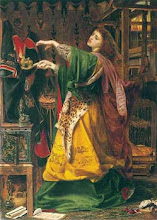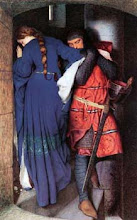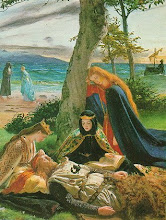Monday, 14 February, 2000, 20:01 GMT
Table turns for King Arthur
Arthur held court in Scotland, says one historian.
King Arthur's legendary round table was based in Scotland - on a site which is now a back garden in Stenhousemuir, says a historian. Scholars have spent decades trying to pinpoint the original location of the famous table, where Arthur is said to have held court with his knights. Until now, the site has always believed to have been in the west country.
Archie McKerracher: Historian
But a Scottish historian says they are wrong - and the round table in fact used to stand in the town of Stenhousemuir, near Falkirk. Archie McKerracher, of the Society of Antiquaries of Scotland, has told how his research shows that King Arthur and his knights actually met on a long-forgotten spot which is now the back garden of an ordinary terraced house. Mr McKerracher says that far from being made of wood or even being a table, the "round table" was really a stone hut. He believes the remains of the hut have been used, one millennium later, as the foundations of a home now happily occupied by a structural consultant and his family. Translations confusion The garden of 40 Adam Crescent, home to Thomas and Charlotte Scott, is now the focus of intense speculation. According to tradition, Arthur was crowned King of Britain in AD 516, when he was only 15.
'All were seated within the circle and no-one was placed outside'
Robert Wace, historian, from 1155
Not long after coming to the throne, legend says he founded the Order of the Knights of the Round Table, choosing those knights whom he considered most brave and noble. Controversy surrounds the question of whether Arthur really existed and some historians have argued he is the personification of several people rolled into one. Mr McKerracher, a fellow of the Society of Antiquaries of Scotland, blames the confusion over the site of the round table on repeated translations of ancient texts. 'A table rotunda' He said: "The principal symbol of Arthurian tales is the legendary Round Table. "The first person to mention it was Robert Wace, who wrote a history of Britain in Norman French in 1155. "What the text actually says is 'Arthur built a table rotunda' - and there is only one building in Britain meriting that description - what is known as Arthur's O'on, or 'rotunda'.
The legend of King Arthur's Round Table has lived for centuries
"Wace added that 'all were seated within the circle and no-one was placed outside' which could hardly mean a circular table but rather a circular building." Mr McKerracher said research showed that Arthur's O'on - derived from the word "oven" - was a beehive-shaped building demolished in 1743 by Sir Michael Bruce of Stenhouse, who used the stones to repair a mill dam. According to Ordnance Survey maps, the site is the back garden of the Scotts' house. Mr Scott said: "I didn't realise it was here when we moved in 24 years ago - there's not really anything to see - but when I put a new wall in some years ago, I had to bend it around a large boulder which could have been a part of it." Middle Eastern mausoleum Mr McKerracher says tales of King Arthur were originally handed down orally in ancient Brittonic Gaelic, recorded in Latin in the early Middle Ages and then translated into the Norman French spoken by the nobility of England. He believes King Arthur built a mausoleum, similar to a type which were fashionable in the Middle East in the fifth century, after making a pilgrimage to Jerusalem. He said: "It seems probable Arthur built his own mauseleum, or 'martyrium', the O'on, to house a secret holy order dedicated to the popular religious cult of Mary Magdalene." Mr McKerracher says other evidence suggests Arthur's kingdom extended from Wales to Dumbarton in Scotland. He believes it was Geoffrey of Monmouth, who wrote the stories of Arthur in 1136, who first moved him to the English west country, in order to please his patron Robert, Earl of Gloucester.


































0 comments:
Post a Comment